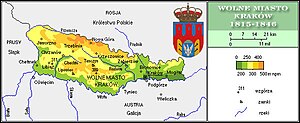Republic of Krakow
| Rzeczpospolita Krakowska | |||||
| Republic of Krakow | |||||
| 1815-1846 | |||||
|
|
|||||
| Official language | Polish | ||||
| Capital | Krakow | ||||
| Form of government | republic | ||||
| surface | 1164 km² | ||||
| population | 95,000 (1815) | ||||
| Population density | 81.6 (1815) inhabitants per km² | ||||
| currency | Krakow zloty | ||||
| founding | May 3, 1815 | ||||
The Republic of Krakow ( Polish: Rzeczpospolita Krakowska ) or Free City of Krakow (Polish: Wolne Miasto Kraków ) was a Polish city-state created by the Congress of Vienna in 1815 with the capital Krakow , which existed until 1846 under the joint protectorate of its neighbors Russia , Prussia and Austria .
history
These three states had divided the aristocratic republic of Poland-Lithuania among themselves in the three partitions of Poland in 1772, 1793 and 1795 . 1807, the French Kaiser founded Napoleon after defeating the Kingdom of Prussia the Duchy of Warsaw , which, territorial cut by Posen , according to the Vienna Convention for the Russian-dominated Congress Poland was.
The Free City of Krakow was officially established by the treaty of Austria, Prussia and Russia on May 3, 1815. It consisted of the city of Krakow and its surroundings (three towns: Chrzanów , Trzebinia and Nowa Góra , and 224 villages) and in 1815 had about 95,000 inhabitants. Their size was 1164 km². With the treaty of 1815 Krakow also received a constitution. The Assembly of Representatives, elected according to census suffrage , then performed the task of the legislature , while the Governing Senate, headed by a President and consisting of twelve members, represented the executive . The judiciary consisted of a court of first instance and a court of appeal . The legal system was based on Napoleon's Civil Code and on French commercial and criminal law. Court proceedings were public; in criminal proceedings, jury members were involved in decision-making based on the French model. The official language was Polish. In 1836, new measures were introduced by edict (see old Polish measures and weights ).
The republic was a duty-free zone with trade relations with Russia, Prussia and Austria, which made the city an important, prosperous trading center for the Central and Eastern European countries . The industrialization developed in the western part of the Republic to the places Jaworzno , Trzebinia, Chrzanów and Libiąż , later than Zagłębie Krakowskie ( "Cracow Mining District") have been combined, but not as strong as in Upper Silesia . By 1843 the population rose to around 143,000, of which around 85 percent were Poles, otherwise the majority were Jews . The Jagiellonian University was privileged students to be able to take from all three countries.
During the November uprising of 1830/1831 Krakow was a base for arms smuggling into Congress Poland, which was ruled by the Tsar . After the victory over the insurgents, the autonomy of the Free City was restricted. From 1833 onwards, the election of the Senate President had to be approved by the three protecting powers, and at the same time the Cracow police were placed under Austrian control. From 1836 to 1841 Krakow was occupied by Austrian , Russian and Prussian troops . The Senate was subjected to the instructions of the three powers, the independent jurisdiction of the city in political matters largely abolished. After an unsuccessful uprising , Krakow was occupied by Austria on November 16, 1846 and incorporated into the Austrian crown land of Galicia as the Grand Duchy of Krakow .
President
- 1840–1846: Johann Baptist Schindler
literature
- Johann Georg Heinrich Hassel : Complete and most recent earth description of the Prussian monarchy and the Cracow Free State. (= Complete manual of the latest description of the earth. ) Department 1, Volume 3, Geographisches Institut, Weimar 1819, pp. 631–640.
- Karl Marx: Lord Palmerston In: MEW 9, (1853) p. 373 ff. (On the Entanglement of England)
- Alfred Regele: The incorporation of the Free State of Krakow in 1846. Unprinted dissertation, Vienna 1951.
- Christian Ortner : The uprising in Cracow and Western Galicia of 1846. In: Heeresgeschichtliches Museum Wien (Ed.): From mercenary armies to UN troops. Armies and wars in Austria and Poland from the 17th to the 20th century. Vienna 2011, ISBN 978-3-902551-22-1 .



